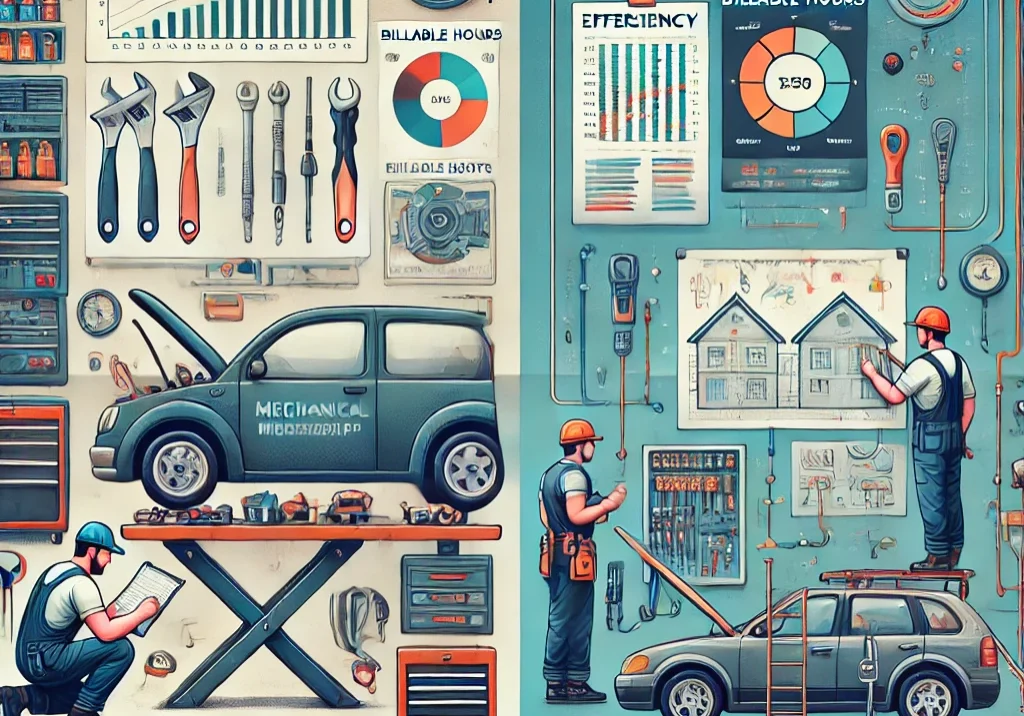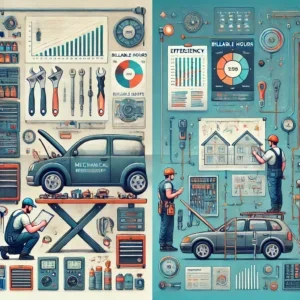
How to Supercharge Productivity and Efficiency in Your Mechanical Workshop
Imagine a mechanical workshop where every spanner is in its place, every lift is in use, and every hour worked brings in revenue. That’s the dream. But if you’re like most workshop owners, it can feel like there are leaks everywhere—lost hours, reworks, and unbilled time.
To fix these leaks, you need to understand two critical metrics: productivity and efficiency. Here’s a clearer, more actionable way to measure, track, and improve these numbers to transform your workshop into a profit powerhouse.
Step 1: Productivity vs Efficiency—Why is it important? And What’s the Difference?
Firstly, Labor is not only one of the most significant costs in your business, but it also presents a major risk for lost revenue opportunities. Consider this: a full-time employee working a standard 38-hour week has 1,710 billable hours annually. At a charge-out rate of $100 per hour, that equates to a potential revenue of $171,000 per person.
However, if this employee operates at 90% productivity (1,710 x 90% = 1,539 hours) and is 88% efficient (1,539 x 88% = 1,354 hours billed), that’s a loss of 356 hours—or $35,600 in missed labour revenue only. Multiply this by 5 or 10 team members, and the losses can quickly escalate, significantly impacting your bottom line.
Second, let’s clear up the confusion. Productivity and efficiency are not the same thing, but they’re closely linked.
Productivity
Productivity measures how much of the time you’re paying for is actually being worked.
- Formula for Productivity:
Hours clocked (B) / Hours employed (A) × 100 = Productivity (%)
- Example:
Bill is employed for 40 hours a week but had one sick day, so he only worked 32 hours.
Formula: 32 hours / 40 hours x 100 = 80% productivity
Efficiency
Efficiency measures how much of the time worked is actually billable to customers.
- Formula for Efficiency:
Hours Billed to Customer (B) / Hours Worked (A)×100 = Efficiency %
- Example:
From the previous example, Bill worked 32 hours. Out of that, he billed out 30 hours.
30 hours billed / 32 hours worked × 100 = 93.8% Efficiency %
Step 2: Why Track Lost Productive and Efficient Time?
Tracking lost time isn’t just about finding faults; it’s about identifying opportunities for improvement.
Lost Productive Time
Productive time is lost when employees are unable to work. This can include:
- Sick Days: Days off due to illness directly reduce productivity.
- Training: While necessary, training means time spent away from billable work.
- Public Holidays: These are paid days but with zero productivity.
Tracking lost productive time helps you identify patterns and make informed decisions about staffing and scheduling. For instance, if sick days are frequent, consider wellness programs or flexible leave policies.
Lost Efficient Time
Efficient time is lost when hours worked don’t translate into billable hours. Examples include:
- Rework: Fixing mistakes from the initial job.
- Warranty Work: Jobs that must be redone under warranty, often for free.
- Non-Billable Time: Time spent on admin, ordering parts, or other tasks that can’t be charged to a customer.
Tracking lost efficient time reveals where your processes need improvement. For example, if rework is a recurring issue, it could point to a need for better training, tools, or systems.
The Purpose of Tracking
By monitoring lost time—both productive and efficient—you can:
- Pinpoint Training Needs: Identify which employees need upskilling or additional support.
- Find Systemisation Opportunities: Automate or streamline repetitive tasks.
- Reduce Costs: Spot inefficiencies that are eating into your profits.
Step 3: Start Measuring Where You Are
You can’t improve what you don’t measure. Begin by tracking your current productivity and efficiency numbers.
Productivity
Start by logging:
- Hours paid (the total hours employees are scheduled to work).
- Hours worked (the actual hours spent at the workshop).
Use the productivity formula to calculate the percentage. If your team is below 80%, look for patterns in absences, training, or other disruptions.
Efficiency
Log:
- Hours clocked on job cards (time spent working on customer jobs).
- Hours billed to customers (time successfully charged).
Use the efficiency formula to see how much of your team’s time is bringing in revenue. If efficiency is below 85%, look for bottlenecks, rework, or tasks that aren’t being billed correctly.
Step 4: Understand Why 100% Productivity and Efficiency Are Unrealistic
While 100% productivity and efficiency sound great on paper, they’re not achievable in real life.
- Productivity: Staff will always need breaks, training, and the occasional sick day.
- Efficiency: Not all hours worked can be billed—warranty work and admin are unavoidable.
Instead of chasing perfection, aim for realistic benchmarks:
- Productivity: around 88% to 90% is a solid goal.
- Efficiency: Anything above 90% to 95% % is excellent.
Step 5: Improve Productivity and Efficiency
Now that you’ve got your baseline, it’s time to plug the leaks.
Improve Productivity
- Plan for Disruptions: Factor in sick days and public holidays when scheduling jobs.
- Invest in Training: While it temporarily reduces productivity, training improves long-term efficiency.
Boost Efficiency
- Systemise Processes: Create templates, checklists, and standard operating procedures for common tasks.
- Automate Where Possible: Use software to track job cards, manage invoices, and schedule work.
- Reduce Rework: Invest in better tools, training, or double-check systems to ensure jobs are done right the first time.
Step 6: Use Gross Profit as Your Guide
Gross profit is the ultimate measure of how well your workshop is running. If it’s trending upwards, your productivity and efficiency efforts are paying off. If not, review your tracking data to identify where the leaks are and adjust accordingly.
Final Thoughts
Running a mechanical workshop is no easy feat, but understanding the difference between productivity and efficiency—and tracking lost time—can help you make meaningful improvements.
Remember, the goal isn’t perfection. It’s about being better tomorrow than you are today. With the right strategies in place, your workshop can become a well-oiled, revenue-generating machine. And hey, if nothing else, you’ll finally know where all those hours are going.
Never miss an article
Subscribe to be notified when new blog articles are posted
"*" indicates required fields




